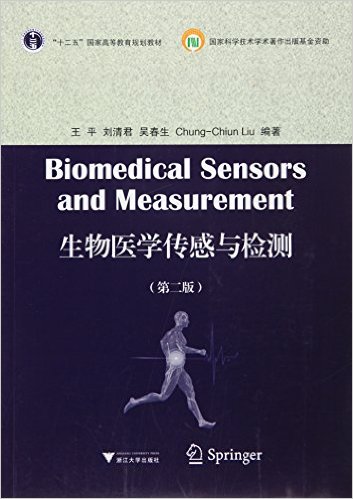[内容简介]
王平、刘清君、吴春生、Chung-Chiun Liu编著的《生物医学传感与检测(第2版十二五国家高等教育规划教材)(英文版)》从信息检测角度介绍了传感器的基本理论、方法以及制作传感器的敏感材料,然后分门别类对物理传感器、化学传感器、生物传感器及在生物医学中的应用作了系统介绍。在此基础上以生物医学传感器的应用为主线,介绍了传感器检测技术及典型生物医学测量系统。
 [作者简介]
[作者简介]
Ping Wang,received his BS, MS and PhD degrees from Electrical Engineering of Harbin Institute of Technology, Harbin, China, in 1984, 1987 and 1992, respectively. From 1992 to 1994 he is Post-doctor in Zhejiang University, China. He was a visiting scholar at Edison Sensors Lab in Case Western Reserve University, USA, and Biosensor and Bioinstrumentation Lab in University of Arkansas, USA. At present, he is a professor in Dept of Biomedical Engineering at Zhejiang University, China.Qingjun Liu,received his PhD degree from Biomedical Engineering of Zhejiang University, China, in 2006. He was a visiting scholar at Dept of Health Technology and Informatics of Hong Kong Polytechnic University, China, and Micro and Nanotechnology Lab in University of Illinois at Urbana-Champaign, USA. At present, he is a professor in Dept of Biomedical Engineering at Zhejiang University, China.Chunsheng Wu,received his PhD degree from Biomedical Engineering of Zhejiang University, China, in 2009. He was a joint PhD student of Micro Systems Lab at University of California, Los Angeles, USA , and an assistant researcher at Aachen University of Applied Sciences, Germany. At present, he is a professor of Biomedical Engineering in medical school at Xi'an Jiaotong University, China.Chung-Chiun Liu,received his MS degree from California Institute of Technology, USA, and PhD degree from Case Western Reserve University, USA, in 1963 and 1968, respectively. At present, he is the Wallace R. Persons Professor of Sensor Technology and Control, Director of Edison Sensors Lab and Electronic Design Center at Case Western Reserve University, USA. He is the Distinguished Professor in the fields of electrochemical and biomedical sensors. Besides, he was a United States President's Award Winner.
[目录]
Chapter 1 Introduction
1.1 Definition and Classification of Biomedical Sensors
1.1.1 Basic Concept of Sensors
1.1.2 Classification of Biomedical Sensors
1.2 Biomedical Measurement Technology
1.2.1 Bioelectrical Signal Detection
1.2.2 Biomagnetic Signal Detection
1.2.3 Other Physiological and Biochemical Parameter Detection
1.3 Characteristics of Biomedical Sensors and Measurement
1.3.1 Features of Biomedical Sensors and Measurement
1.3.2 Special Requirements of Biomedical Sensors and Measurement
1.4 Development of Biomedical Sensors and Measurement
1.4.1 Invasive and Non—Invasive Detection
1.4.2 Multi—Parameter Detection
1.4.3 In vitro and In vivo Detection
1.4.4 Intelligent Artificial Viscera
1.4.5 Micro—Nano Systems
1.4.6 Biochips and Microfluidics
1.4.7 Biomimetic Sensors
References
Chapter 2 Basics of Sensors and Measurement
2.1 Introduction
2.2 Sensor Characteristics and Terminology
2.2.1 Static Characteristics
2.2.2 Dynamic Characteristics
2.3 Sensor Measurement Technology
2.3.1 Measurement Methods
2.3.2 Sensor Measurement System
2.3.3 Signal Modulation and Demodulation
2.3.4 Improvement of Sensor Measurement System
2.4 Biocompatibility Design of Sensors
2.4.1 Concept and Principle of Biocompatibility
2.4.2 Biocompatibility for Implantable Biomedical Sensors
2.4.3 Biocompatibility for In vitro Biomedical Sensors
2.5 Microfabrication of Biomedical Sensors
2.5.1 Lithography
2.5.2 Film Formation
2.5.3 Etching
2.5.4 Design of the Biomedical Sensors
References
Chapter 3 Physical Sensors and Measurement
3.1 Introduction
3.2 Resistance Sensors and Measurement
3.2.1 Resistance Strain Sensors
3.2.2 Piezoresistive Sensors
3.3 Inductive Sensors and Measurement
3.3.1 Basics
3.3.2 Applications in Biomedicine
3.4 Capacitive Sensors and Measurement
3.4.1 The Basic Theory and Configuration of Capacitive Sensors
3.4.2 Measurement Circuits
3.4.3 Biomedical Applications
3.5 Piezoelectric Sensors and Measurement
3.5.1 Piezoelectric Effect
3.5.2 Piezoelectric Materials
3.5.3 Measurement Circuits
3.5.4 Biomedical Applications
3.6 Magnetoelectric Sensors and Measurement
3.6.1 Magnetoelectric Induction Sensors
3.6.2 Hall Magnetic Sensors
3.7 Photoelectric Sensors
3.7.1 Photoelectric Element
3.7.2 Fiber Optic Sensors
3.7.3 Applications of Photoelectric Sensors
3.8 Thermoelectric Sensors and Measurement
3.8.1 Thermosensitive Elements
3.8.2 Thermocouple Sensors
3.8.3 Integrated Temperature Sensors
3.8.4 Biomedical Applications
References
Chapter 4 Chemical Sensors and Measurement
4.1 Introduction
4.1.1 History
4.1.2 Definition and Principle
4.1.3 Classification and Characteristics
4.2 Electrochemical Fundamental
4.2.1 Measurement System
4.2.2 Basic Conception
4.2.3 Classification of Electrodes
4.3 Ion Sensors
4.3.1 Ion—Selective Electrodes
4.3.2 Ion—Selective Field—Effect Transistors
4.3.3 Light Addressable Potentiometric Sensors
4.3.4 Microelectrode Array
4.4 Gas Sensors
4.4.1 Electrochemical Gas Sensors
4.4.2 Semiconductor Gas Sensors
4.4.3 Solid Electrolyte Gas Sensors
4.4.4 Surface Acoustic Wave Sensors
4.5 Humidity Sensors
4.5.1 Capacitive Humidity Sensors
4.5.2 Resistive Humidity Sensors
4.5.3 Thermal Conductivity Humidity Sensors
4.5.4 Application
4.6 Intelligent Chemical Sensor Arrays
4.6.1 e—Nose
4.6.2 e—Tongue
4.7 Micro Total Analysis System
4.7.1 Design and Fabrication
4.7.2 Applications
4.8 Sensor Networks
4.8.1 History of Sensor Networks
4.8.2 Essential Factors of Sensor Networks
4.8.3 Buses of Sensor Networks
4.8.4 Wireless Sensor Network
References
Chapter 5 Biosensors and Measurement
5.1 Introduction
5.1.1 History and Concept of Biosensors
5.1.2 Components of Biosensor
5.1.3 Properties of Biosensors
5.1.4 Common Bioreceptor Components
5.2 Catalytic Biosensors
5.2.1 Enzyme Biosensors
5.2.2 Microorganism Biosensors
5.3 Affinity Biosensors
5.3.1 Antibody and Antigen Biosensors
5.3.2 Nucleic Acid Biosensors
5.3.3 Receptor and Ion Channel Biosensors
5.4 Cell and Tissue Biosensors
5.4.1 Cellular Metabolism Biosensors
5.4.2 Cellular Impedance Biosensors
5.4.3 Extracellular Potential Biosensors
5.5 Biochips
5.5.1 Chips of Microarray
5.5.2 Gene and Protein Chips
5.5.3 Tissue and Cell Chips
5.5.4 Lab—on—a—Chip
5.6 Nano—Biosensors
5.6.1 Nanomaterials for Biosensors
5.6.2 Nanoparticles and Nanopores Biosensors
5.6.3 Nanotubes and Nanowires Biosensors
References
Index

 新书报道
新书报道